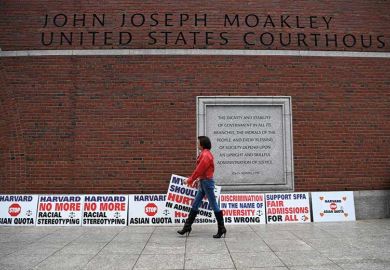Elite US universities are pushing back on pressure to end legacy admissions, seeing little potential gain in equity, especially after having spent years diversifying their alumni.
The question has gained renewed prominence with Amherst College’s recent promise to end preferences for applicants with a parent among its degree holders.
“Now is the time to end this historic programme that inadvertently limits educational opportunity by granting a preference to those whose parents are graduates of the college,” Amherst’s president, Biddy Martin, said in announcing the move last month.
Other prominent institutions that have ended legacy preferences include Johns Hopkins University, the Massachusetts Institute of Technology, the California Institute of Technology and Pomona College.
THE Campus resource: Equitable teaching that creates pathways to success for all students
Yet many other top-ranked US institutions have refused, and Amherst’s move has driven up pressure on them to change course. “Princeton, your turn,” Jennifer Jennings, a professor of sociology and public affairs at Princeton University, wrote on Twitter after Amherst’s announcement.
Institutions on both sides of the question, however, acknowledge many complexities in assessing the case for legacy preferences – even if measured by effects on overall equity.
Legacy preferences – still common practice at nearly three-quarters of highly selective US institutions – have long been regarded as an attempt to encourage donations by pleasing alumni. In reality, said Christopher Rim, a college admissions consultant, ending them might also help institutions financially. That is because alumni advantages typically take places from other applicants of relatively advantaged backgrounds; thus, he continued, ending those set-asides could give institutions access to major donor families beyond their existing cores.
Also, wealthy families tend to donate to selective colleges in the years just before their children apply if they feel they have a chance of winning admission, said Mr Rim, chief executive of Command Education.
“It’s going to open the door to a lot of potential new donors for a lot of these schools,” especially the smaller top-tier institutions, Mr Rim said of policy changes that end legacy preferences.
At Amherst, children of alumni account for about 11 per cent of admitted students – all of them are taken from a pool of applicants already judged as deserving admission based on their academic merit. The college estimates that ending its prescribed legacy preference should cut that share roughly in half.
The equity effect could be magnified in Amherst’s particular case because the college simultaneously announced an increase in its available student financial aid, to $71 million (£52 million) a year. That is enough to offer free tuition to accepted students coming from about 80 per cent of US households, or about 60 per cent of current Amherst students, the college said.
Matthew McGann, the dean of admissions and financial aid at Amherst, said the college had no defined rationale for granting legacy preferences. Other institutions, however, have talked about student-to-student benefits. Harvard University has said that its hereditary set-aside provides its non-legacy freshmen with classmates who are familiar with the institution. Brown University has talked of legacy students helping to mentor their counterparts.
Williams College – one of the three “Little Ivies”, along with Amherst and Wesleyan University – also sees legacy preferences as reinforcing generations of alumni passing along mentoring, internship and career opportunities.
“The idea of eliminating legacies is gaining steam at exactly the moment when our alumni body is becoming more racially and socio-economically diverse because of changes in admissions policies decades ago,” said a Williams spokesman. “We don’t want to shut that door.”
At Brown, about one-fifth of the children of alumni whom it enrols are from racial minorities, and about a third have qualified for financial aid. “These students reflect the growing diversity of our campus and, therefore, our alumni base,” the university’s dean of admissions, Logan Powell, has said in defending the policy.
Amherst announced the end of its legacy preferences as the campus of nearly 2,000 students in rural western Massachusetts neared the completion of a five-year fundraising campaign seeking $625 million. Professor Martin rejected any connection on the timing, saying: “We’re doing this because we can do it, and because we should do it.”
The decision did, however, require an assessment of trade-offs, Mr McGann conceded. “There were definitely people who were unhappy,” he said. “Sometimes it can be easier to just keep doing what you’ve been doing and not rock the boat and not make anybody particularly happy or unhappy.”
Mr Rim agreed that legacy admissions was a tough issue for institutions, and that ending it only worked to “slightly level the playing field” among various types of college applicants.
At the same time, he said, it is a deeply ingrained expectation. As a graduate of Yale University, Mr Rim recalled that more than half his friends were legacies, in many instances traced to both parents and some grandparents. “That’s going to be a hard policy or tradition to really change,” he said.
He also questioned the purported benefit of being surrounded by freshmen with parental ties to the institution. “They’re my closest friends now,” he said of his legacy-status classmates. But as for any early advantages they provided: “Nope. Zero. Absolutely nothing.”
POSTSCRIPT:
Print headline: US elite resist pressure to end preferences for alumni’s children
Register to continue
Why register?
- Registration is free and only takes a moment
- Once registered, you can read 3 articles a month
- Sign up for our newsletter
Subscribe
Or subscribe for unlimited access to:
- Unlimited access to news, views, insights & reviews
- Digital editions
- Digital access to THE’s university and college rankings analysis
Already registered or a current subscriber? Login







